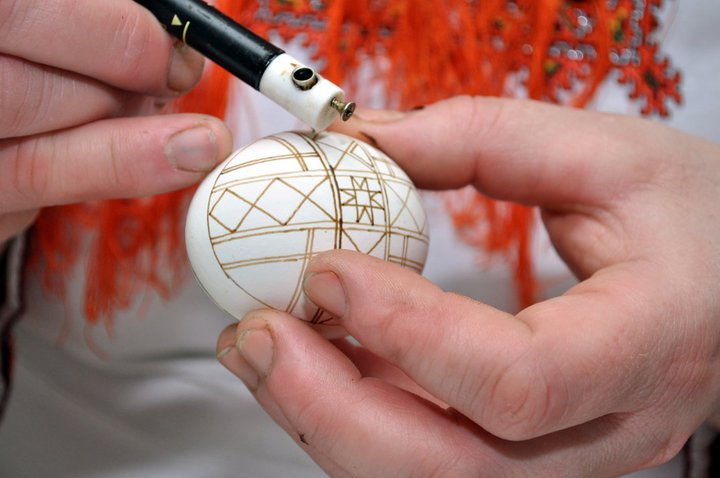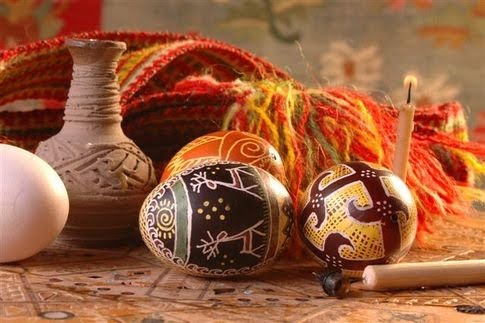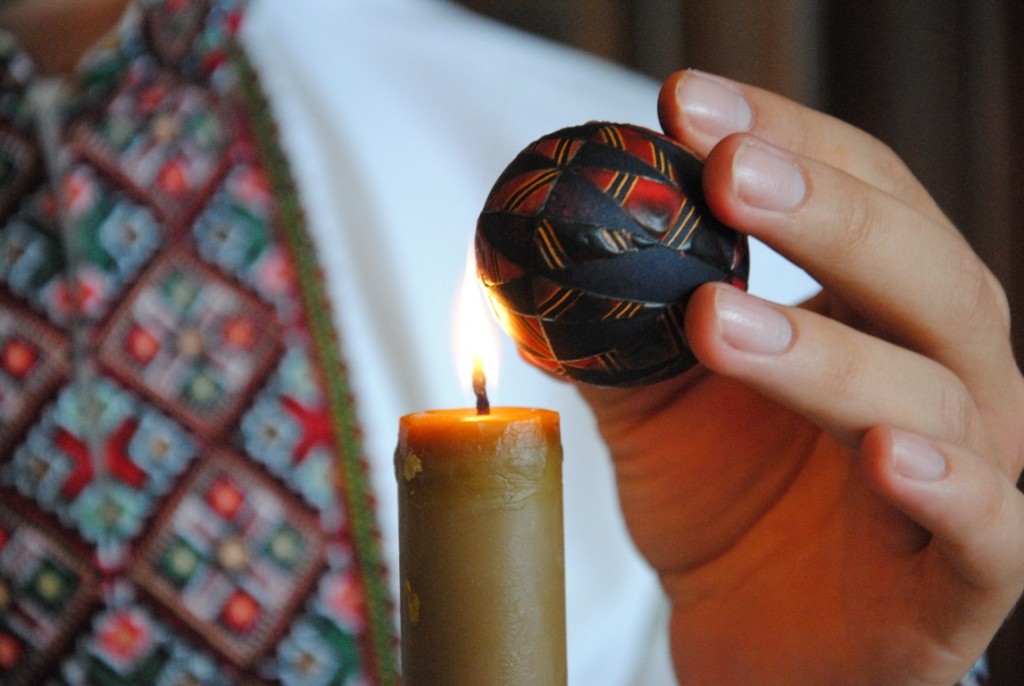So what is «pysanka»? The name derives from the Ukrainian verb “pysaty,” meaning “to write.” (“Pysanka” is the singular form; “pysanky” is plural.) Traditionally, «pysanky» were made of hard boiled eggs. The eggs were left whole. They would eventually dry out and become light. Later Ukrainians started to create «pysanky» on the egg shells, these items were used as presents to friends and family on Easter Sunday. «Pysanka» on the egg shell if made correctly (there is a whole special procedure how to blow out the whites and the yolk from the egg shell to save it from fractures and other defects) can be preserved for many years.


Read: Easter Baskets by Borysov Gastrofamily
Easter eggs in Ukraine are mainly decorated using a wax resist method. The method is similar to batik - patterns are drawn on the egg with wax, which then protects the covered areas from the dye that is applied. By repeating this process with different colors of dye, a multi-colored pattern is built up. Finally, the wax is removed to reveal the colors that were covered up at each stage. A layer of polyurethane can be added over the finished egg to protect the dyed design and to give a gloss finish.
There also other less known techniques, such as «scratching» (the pattern is scratched on the painted eggshell with a needle) or «perforating» (the pattern is created with the numerous tiny perforations on the egg shell).

Ukrainians have been decorating eggs, creating these miniature masterpieces, for countless generations. There is a ritualistic element involved, spiritual thinking and the need for creating special gifts for the gods and goddesses who will grant people health, fertility, love, and wealth. There is a yearning for eternity, for the sun and stars and nature powers.
The ethnic group of Hutzuls who reside in the highlands of Carpathian Mountains take «pysanky» super seriously, they believe that the fate of the world depends on decorated Easter eggs. The world will exist as long as egg-decorating continues. Should the custom cease, evil…in the guise of a monster chained to a huge cliff, will encompass the world and destroy it. Each year the monster’s servants encircle the globe, keeping record of the number of «pysanky» made. When there are few, the monster’s chains loosen, and evil flows through the world. When there are many, the chains hold taut, allowing love to conquer evil. Also from the Hutzuls comes a story of the Blessed Virgin Mary. They say that the first «pysanky» were decorated by the tears of the Blessed Virgin Mary, who was taking eggs to Pontius Pilate as a ransom for her son. Climbing the stairs, she tripped, and the «pysanky» scattered all over the world.

Read: Popular Easter Recipes in Ukraine
The design motifs on «pysanky» date back to pre-Christian times. Many date back to early Slavic cultures, while other are proven to date back to the days of the Trypillians, Neolithic ancestors, others to Paleolithic times.
While the symbols have remained through the ages, their interpretation has changed, in an act of religious syncretism. A triangle that once spoke of the three elements, earth, fire and air, now celebrates the Christian Holy Trinity. The cross which depicted the rising sun is now the symbol of the risen Christ. Sun and star symbols once referred to Dazhboh, the sun god, now refer to the one Christian God. And the fish, which spoke of a plentiful catch and a full stomach, now stands in for Christ, the fisher of men. Even so, under this Christian veneer, there still lurk the berehynia and the serpent, the sun and the moon, the old gods, the old ways, and the old beliefs.

The geometric motifs are the same as found in many forms of primitive art, but their use in «pysanky» gives them specific names and symbolic meanings. Ribbons and belts that encircle the egg with no beginning or end symbolize eternity. Triangles symbolize trios, such as the circle of life of birth, life, death; the Holy Trinity, and the natural elements of fire, air, and water. Stars once symbolized the pagan gods, and now stand for life, growth and good fortune. The cross appears in many forms and symbolizes the four corners of the world, and Christianity.
The floral motifs such as flowers, leaves, and branches are also very popular patterns and symbolize love, charity, good-will, strength, virility, health and a bountiful harvest. Pine trees symbolize eternal youth, strength and health.

In some regions of Ukraine (mostly Western part of the country) animal motifs are often seen on «pysanky». Reindeer and horses symbolize wealth and prosperity. Birds are mostly depicted at rest. Hens, which symbolize fertility and the fulfillment of wishes, are often placed on branches. All drawings of insects are called butterflies, and are the symbol of the Resurrection.
The eggs, covered with symbols, are dyed in warm colors dominated by red, the life-giving substance blood, stands for love and happiness. Other colors are yellow, the color of ripe crops, honey and amber, gold represents the moon and wish for a good harvest. Green symbolizes the growth power of plants. Brown and black is the Mother Earth. White symbolizes purity.

Read: The Ultimate Guide to April Festivals in Ukraine
The tradition of the Ukrainian Easter Egg has been passed down from mother to daughter to many, many generations. These days this unique Ukrainian cultural heritage provides the world with Easter Eggs that are truly works of art.
Photo source: shutterstock.com, pinterest.com







